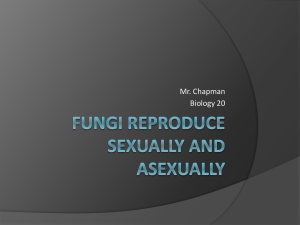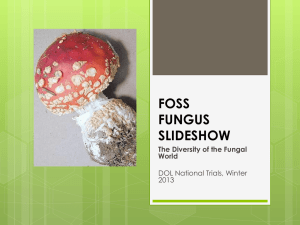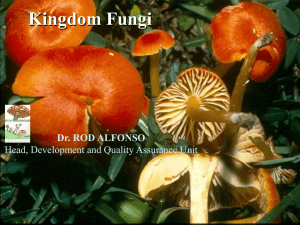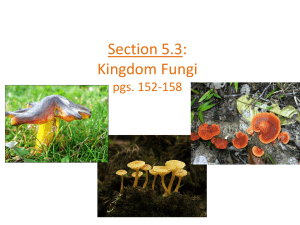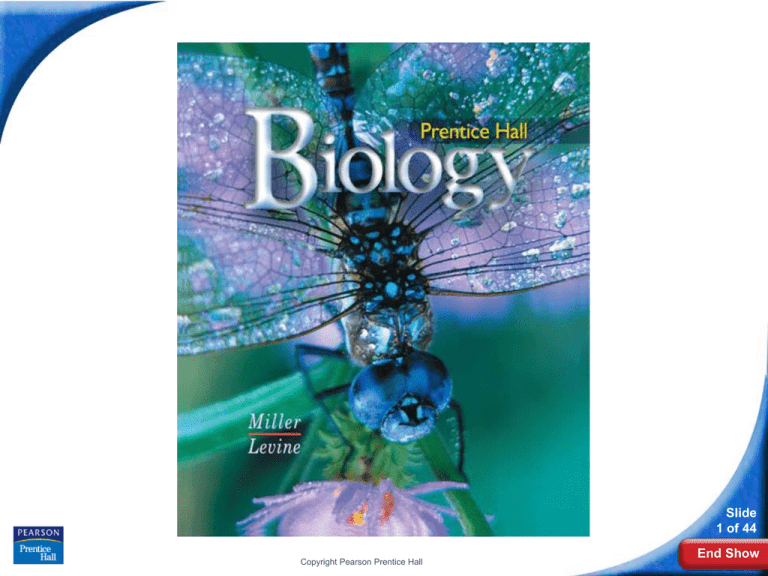
Biology
Biology
Slide
1 of 44
Copyright Pearson Prentice Hall
End Show
21-2 Classification of Fungi
Slide
2 of 44
Copyright Pearson Prentice Hall
End Show
21-2 Classification of Fungi
Classification
Fungi are classified according to their structure and
method of reproduction.
The four main groups of fungi are:
• Common molds (Zygomycota)
• Sac fungi (Ascomycota)
• Club fungi (Basidiomycota)
• Imperfect fungi (Deuteromycota)
Slide
3 of 44
Copyright Pearson Prentice Hall
End Show
21-2 Classification of Fungi
The Common Molds
The Common Molds
What are the characteristics of the
common molds?
Slide
4 of 44
Copyright Pearson Prentice Hall
End Show
21-2 Classification of Fungi
The Common Molds
Familiar molds that grow on meat, cheese, and
bread are called zygomycetes.
Slide
5 of 44
Copyright Pearson Prentice Hall
End Show
21-2 Classification of Fungi
The Common Molds
Zygomycetes have life cycles that
include a zygospore.
A zygospore is a resting spore that contains
zygotes formed during the sexual phase of
the mold's life cycle.
Slide
6 of 44
Copyright Pearson Prentice Hall
End Show
21-2 Classification of Fungi
The Common Molds
Structure and Function of Bread Mold
Black bread mold, Rhizopus stolonifer, is a
zygomycete.
Black bread mold has two types of hyphae:
• Rhizoids are rootlike hyphae that penetrate
the bread's surface.
• Stolons are stemlike hyphae that run along
the surface of the bread.
Slide
7 of 44
Copyright Pearson Prentice Hall
End Show
21-2 Classification of Fungi
The Common Molds
Life Cycle of Molds
Black bread molds reproduce both sexually and
asexually.
Slide
8 of 44
Copyright Pearson Prentice Hall
End Show
21-2 Classification of Fungi
The Common Molds
Life Cycle of a Black Bread Mold
FERTILIZATION
MEIOSIS
Sexual
Reproduction
Asexual
Reproduction
Slide
9 of 44
Copyright Pearson Prentice Hall
End Show
21-2 Classification of Fungi
The Common Molds
Hyphae from different mating types fuse and produce
gamete-forming structures called gametangia.
Gametangia
+ Mating type (N)
- Mating type (N)
Stolon
Rhizoids
Slide
10 of 44
Copyright Pearson Prentice Hall
End Show
21-2 Classification of Fungi
The Common Molds
Haploid (N) gametes produced in the gametangia
fuse with gametes of the opposite mating type to form
diploid (2N) zygotes.
Zygotes develop into thick-walled zygospores.
Slide
11 of 44
Copyright Pearson Prentice Hall
End Show
21-2 Classification of Fungi
The Common Molds
In favorable conditions, the zygospore germinates,
undergoes meiosis, and releases new haploid
Zygospore (2N)
spores.
Sporangium
Spores (N)
MEIOSIS
Zygospore (2N)
Sexual
Reproduction
Slide
12 of 44
Copyright Pearson Prentice Hall
End Show
21-2 Classification of Fungi
The Common Molds
The sporangium reproduces asexually by releasing
haploid spores produced by meiosis.
Sporangium
Spores (N)
Sporangiophore
Rhizoids
Slide
13 of 44
Copyright Pearson Prentice Hall
End Show
21-2 Classification of Fungi
The Sac Fungi
The Sac Fungi
What are the characteristics of the sac
fungi?
Slide
14 of 44
Copyright Pearson Prentice Hall
End Show
21-2 Classification of Fungi
The Sac Fungi
The phylum Ascomycota is named for the
ascus, a reproductive structure that
contains spores.
Slide
15 of 44
Copyright Pearson Prentice Hall
End Show
21-2 Classification of Fungi
The Sac Fungi
Life Cycle of Sac Fungi
The life cycle of an ascomycete usually includes
both asexual and sexual reproduction.
Slide
16 of 44
Copyright Pearson Prentice Hall
End Show
21-2 Classification of Fungi
The Sac Fungi
Sexual
Reproduction
Asexual Reproduction
Copyright Pearson Prentice Hall
Slide
17 of 44
End Show
21-2 Classification of Fungi
The Sac Fungi
In asexual reproduction, spores called conidia form
at tips of conidiophores.
Conidiophores are specialized hyphae.
Slide
18 of 44
Copyright Pearson Prentice Hall
End Show
21-2 Classification of Fungi
The Sac Fungi
During sexual reproduction, haploid hyphae of two
different mating types (+ and - ) grow close together.
Hyphae
(N) + (N)
Hyphae (N)
Gametangia
+ Mating type (N)
- Mating type (N)
Copyright Pearson Prentice Hall
Slide
19 of 44
End Show
21-2 Classification of Fungi
The Sac Fungi
The N + N hyphae then produce a fruiting body in
which sexual reproduction continues.
The ascus forms within the fruiting body.
Within the ascus, two nuclei of different mating types
fuse to form a diploid zygote (2N).
Slide
20 of 44
Copyright Pearson Prentice Hall
End Show
21-2 Classification of Fungi
The Sac Fungi
Fruiting body (N + N)
Ascus (N + N)
Zygote (2N)
Asci
Slide
21 of 44
Copyright Pearson Prentice Hall
End Show
21-2 Classification of Fungi
The Sac Fungi
The zygote divides by meiosis, producing four
haploid cells.
In most ascomycetes, meiosis is followed by mitosis,
so that eight cells called ascospores are produced.
An ascospore can germinate and grow into a haploid
mycelium.
Slide
22 of 44
Copyright Pearson Prentice Hall
End Show
21-2 Classification of Fungi
The Sac Fungi
Ascus
Hypha (N)
8 Ascospores
(N)
Slide
23 of 44
Copyright Pearson Prentice Hall
End Show
21-2 Classification of Fungi
The Sac Fungi
Yeasts
Yeasts are unicellular fungi.
Yeasts reproduce asexually by budding.
Dry granules of yeast contain ascospores, which
become active in a moist environment.
Slide
24 of 44
Copyright Pearson Prentice Hall
End Show
21-2 Classification of Fungi
The Club Fungi
The Club Fungi
What are the characteristics of the club
fungi?
Slide
25 of 44
Copyright Pearson Prentice Hall
End Show
21-2 Classification of Fungi
The Club Fungi
The phylum Basidiomycota, or club fungi,
gets its name from a specialized
reproductive structure that resembles a
club.
The spore-bearing structure is called the
basidium.
Slide
26 of 44
Copyright Pearson Prentice Hall
End Show
21-2 Classification of Fungi
The Club Fungi
Life Cycle of Club Fungi
Basidiomycetes undergo an elaborate life cycle.
Slide
27 of 44
Copyright Pearson Prentice Hall
End Show
21-2 Classification of Fungi
The Club Fungi
Life Cycle of Club Fungi
Slide
28 of 44
Copyright Pearson Prentice Hall
End Show
21-2 Classification of Fungi
The Club Fungi
A basidiospore germinates to produce a haploid
primary mycelium.
Slide
29 of 44
Copyright Pearson Prentice Hall
End Show
21-2 Classification of Fungi
The Club Fungi
The mycelia of
different mating types
fuse to produce a
secondary mycelium.
The cells of the
secondary mycelium
contain haploid nuclei
of each mating type.
Slide
30 of 44
Copyright Pearson Prentice Hall
End Show
21-2 Classification of Fungi
The Club Fungi
When the right combination of moisture and nutrients
occurs, spore-producing fruiting bodies push above
the ground.
Fruiting body (N + N)
Gills lined with basidia
Gills
Cap
Stalk
Base
Basidia
(N +N)
Slide
31 of 44
Copyright Pearson Prentice Hall
End Show
21-2 Classification of Fungi
The Club Fungi
When the mushroom cap opens, it exposes hundreds
of tiny gills on its underside.
Each gill is lined with basidia.
Fruiting body (N + N)
Gills lined with
basidia
Gills
Cap
Stalk
Base
Basidia
(N +N)
Slide
32 of 44
Copyright Pearson Prentice Hall
End Show
21-2 Classification of Fungi
The Club Fungi
Nuclei in each basidium fuse, forming a diploid
zygote, which undergoes meiosis, forming clusters of
haploid basidiospores.
Zygote (2N)
Basidiospores (N)
Slide
33 of 44
Copyright Pearson Prentice Hall
End Show
21-2 Classification of Fungi
The Club Fungi
Basidiospores form at the edge of each basidium and
are ready to be scattered.
Zygote (2N)
Basidiospores (N)
Slide
34 of 44
Copyright Pearson Prentice Hall
End Show
21-2 Classification of Fungi
The Club Fungi
Diversity of Club Fungi
Basidiomycetes include shelf fungi, puffballs,
earthstars, jelly fungi, and rusts.
Slide
35 of 44
Copyright Pearson Prentice Hall
End Show
21-2 Classification of Fungi
The Imperfect Fungi
The Imperfect Fungi
What are the characteristics of the
imperfect fungi?
Slide
36 of 44
Copyright Pearson Prentice Hall
End Show
21-2 Classification of Fungi
The Imperfect Fungi
Imperfect fungi, or Deuteromycota, are
fungi that cannot be placed in other
phyla because researchers have never
been able to observe a sexual phase in
their life cycles.
Slide
37 of 44
Copyright Pearson Prentice Hall
End Show
21-2 Classification of Fungi
The Imperfect Fungi
A well-known genera of the imperfect fungi is
Penicillium.
Penicillium notatum is a mold that is the source of the
antibiotic penicillin.
Slide
38 of 44
Copyright Pearson Prentice Hall
End Show
21-2
Click to Launch:
Continue to:
- or -
Slide
39 of 44
End Show
Copyright Pearson Prentice Hall
21-2
Fungi grow best in an environment that is
a. cool.
b. moist.
c. dry.
d. salty.
Slide
40 of 44
End Show
Copyright Pearson Prentice Hall
21-2
Yeasts are
a. ascomycetes.
b. zygomycetes.
c. basidiomycetes.
d. deuteromycetes.
Slide
41 of 44
End Show
Copyright Pearson Prentice Hall
21-2
Penicillium is a(an)
a. ascomycete.
b. basidiomycete.
c. deuteromycete.
d. zygomycete.
Slide
42 of 44
End Show
Copyright Pearson Prentice Hall
21-2
Sac fungi have a characteristic reproductive
structure called a(an)
a. ascus.
b. basidium.
c. budding capsule.
d. sporophyte.
Slide
43 of 44
End Show
Copyright Pearson Prentice Hall
21-2
The basidiospores of club fungi are produced on
thin structures called
a. fruiting bodies.
b. buttons.
c. gills.
d. stalks.
Slide
44 of 44
End Show
Copyright Pearson Prentice Hall
END OF SECTION

